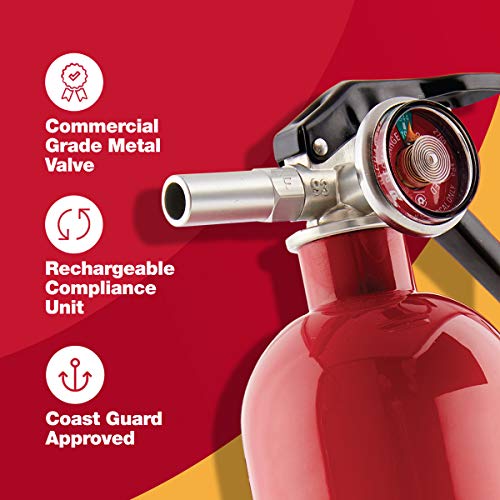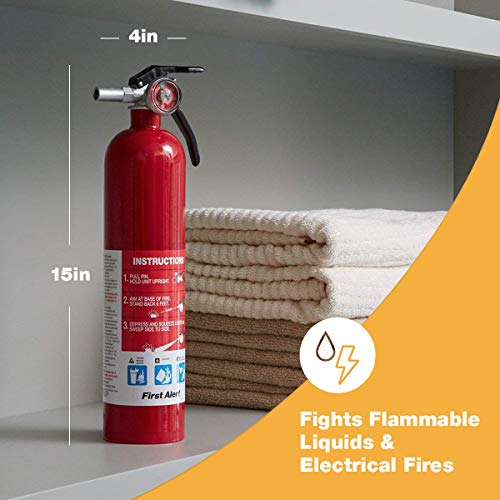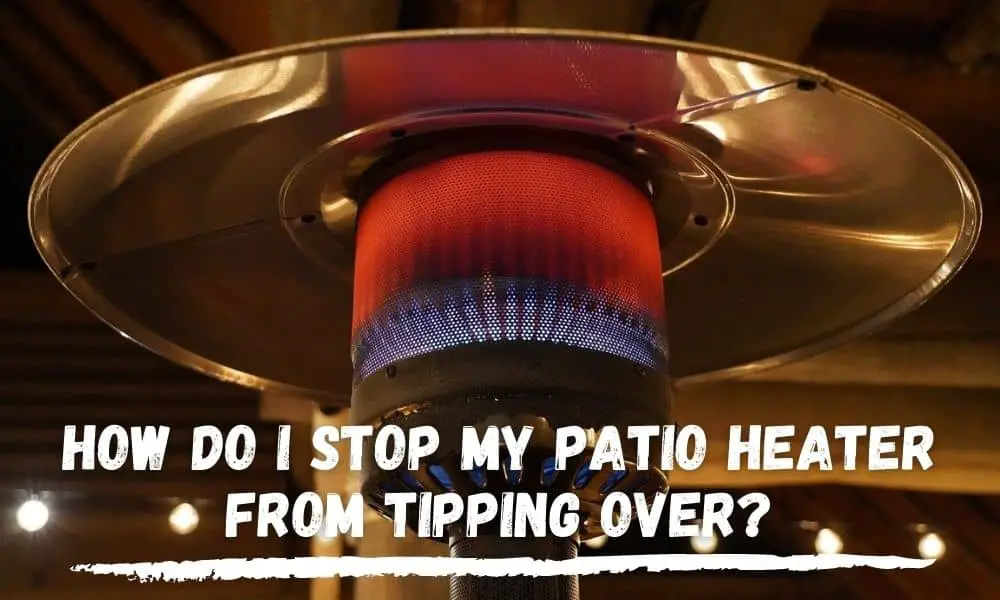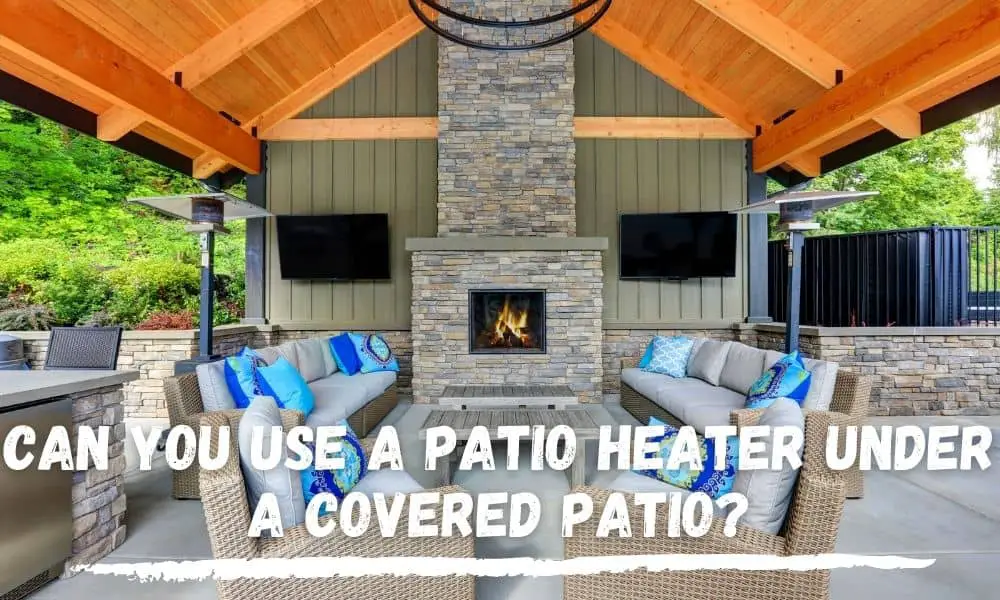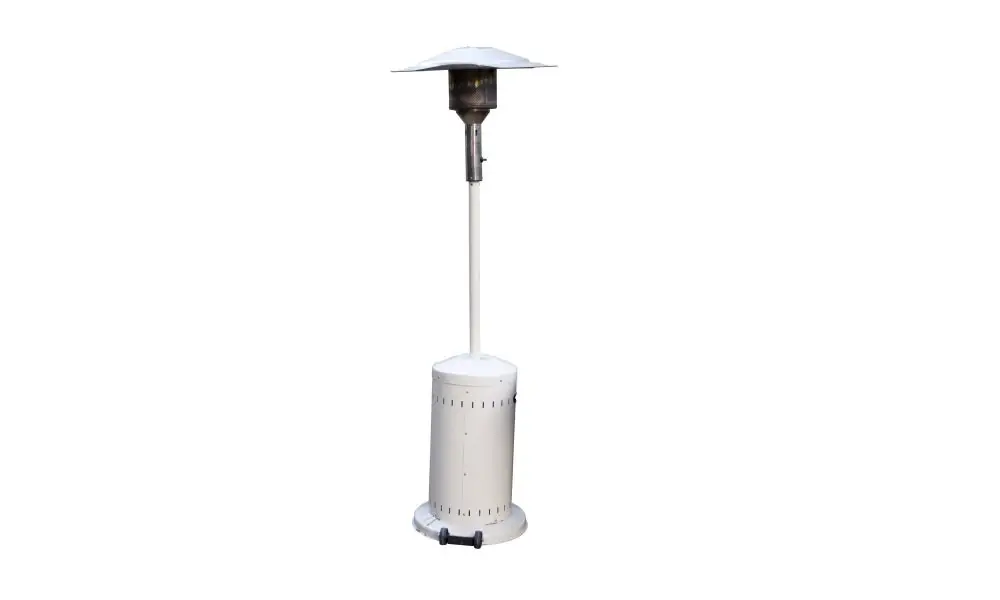Whether your patio deck is a DIY project or you got a carpenter to make it for you, it was somewhat costly.
You may be unsure if it is safe to put a fire pit on your wood, vinyl, or composite deck. Not to mention, there are many rules concerning the usage of fire pits.
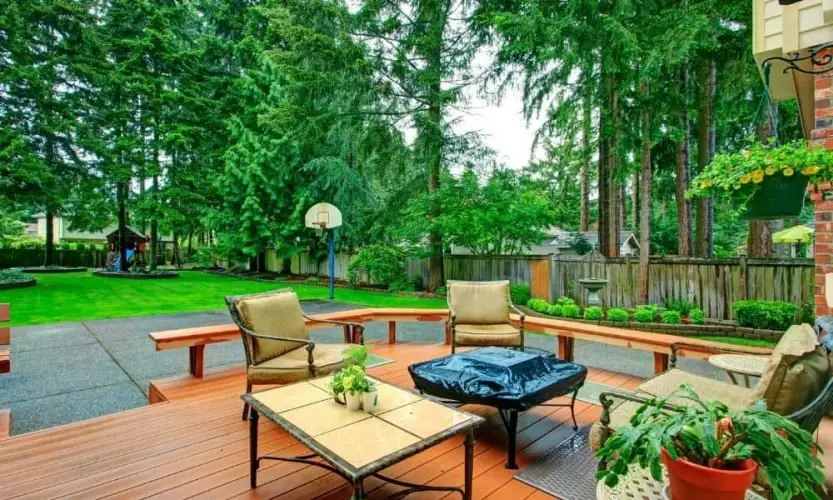
Is it possible to use a fire pit on decking?
Using a fire pit on a wooden, vinyl, or composite deck is possible, but you should consider some factors. For instance, it would be best if you observed a certain distance(depending on your location). Also, you should minimize smoke and spark ejection. For all the safety tips about using a fire pit on a deck, read our ultimate guide.
Quick Navigation
- Is It Safe to Use a Fire Pit on a Wooden Deck?
- A Few Things Before You Purchase or Install a Fire Pit for Your Deck
- The Meaning of Composite Decking
- To What Extent Can a Fire Pit Heat Up?
- Fire Pits on Top of a Wooden Deck
- Fire Pits on Top of a Composite Deck
- What Do You Put Under a Fire Pit on a Deck?
- The Distance of Your Fire Pit From Your House
- How Do You Use a Fire Pit on a Wood Deck?
- What Is the Best Fire Pit for a Deck?
- FAQs
- Conclusion
Is It Safe to Use a Fire Pit on a Wooden Deck?
As earlier stated, using a fire pit on decking, whether composite, vinyl, or wooden decks, is safe. However, you have to consider the location of your fire pit. You should also have a fire-resistant surface between the fire pit and the wooden deck.
Concrete decks are the easiest surface to maintain when using fire pits as they are fire-resistant. However, constructing a concrete deck is more costly than wood, vinyl, and composite decks.
A Few Things Before You Purchase or Install a Fire Pit for Your Deck
Apart from your budget and designs, here is what to consider before getting a fire pit for your deck.
Guiding Information
You can find guiding information on your desired fire pit from a user manual. This information is usually available on the manufacturer’s website.
Always look at what the guiding information entails to ensure that a fire pit is ideal for your deck. The manual can also help you determine whether or not you can use the fire pit on a combustible deck.
Weight Requirements
A fire pit, especially if it needs a stone base, is bulky. Upon confirming from the user manual that a fire pit is a good option, you need to determine if your deck can support the additional weight. Here is how to know if your deck can support the weight of a particular fire pit.
- Look at the weight of the fire pit plus any fire pit accessories needed.
- Add this to the weight of your patio furniture and that of users on the patio at any time.
- Compare the total weight to that which your deck can support.
- If you don’t know the weight your deck can support, get help from a structural engineer.
The Meaning of Composite Decking
Composite decking consists of wood fibers, polypropylene, polyvinyl chloride, and other plastic materials. Some companies will not put any wooden products in their composite decks.
A composite deck is more resistant to discoloration and rotting than a wooden deck. On the downside, a composite deck is susceptible to heat and can grow very hot, making it uncomfortable to walk on bare feet.
Despite that, composite decks cost more to make than pressure-treated wooden decks. Typically, composite decking costs $10-$20 per square foot without factoring in installation costs.
Some of the top brands that offer composite decking include:
- Trex
- TimberTech
- Fiberon
- Envision
- CaliBamboo
To What Extent Can a Fire Pit Heat Up?
If you have a wood fire pit, you can get up to 1100 Celsius or 1200 Fahrenheit. This temperature is similar to that of a bonfire. The only difference is that a fire pit is off the ground while a bonfire is on the ground.
Due to the high temperature, you should be extra careful, or your fire pit might destroy your wood deck.
Fire Pits on Top of a Wooden Deck
There are a few challenges you can face if you have a fire pit on a wood deck. These include;
- Full destruction and fire damage to your wood deck or weakening of the support structure
- Cosmetic damage as a result of metal scorching the wood deck
- Hot contents from your fire pit spewing onto the wood deck and burning some sections.
Are you regularly using a fire pit and want to replace or build a new wooden deck? Make sure to use fire-resistant pressure-treated wood. This ensures longevity and supplements other wood deck protection measures, which we will discuss in a few.
Fire Pits on Top of a Composite Deck
The challenges faced when using a wood deck are similar to those of a composite deck. A composite deck is typically fire-resistant but not immune to the effects of your fire pit.
As earlier indicated, composite decking will contain plastics like polypropylene and polyvinyl chloride. Under high heat, such as from a fire pit, your composite deck can warp or melt.
Polypropylene begins to melt from 320-degrees Fahrenheit while PVC from 212-degrees Fahrenheit. So, it would be best if you were extra careful with your fire pit when using a composite deck.
What Do You Put Under a Fire Pit on a Deck?
So far, we know that the only way to prevent heat or ember damage from your fire pit is by using a barrier. There is a variety of affordable DIY and store products available for you to use. With these products, you will enjoy your investment value irrespective of what type of deck you have.
A DIY Fire Pad For Your Fire Pit
A fire pit pad is the most affordable option, but it’s still quite efficient. You can take unused pavers lying in your shed or garage to make a fire pit pad. When making a fire pit pad.
- Select the location on your wooden deck for your fire pit.
- Arrange your pavers side to side for a base for the legs of your fire pit or the entire pit.
- Make sure to be extra-cautious while placing pavers, especially a composite deck. You do not want to scratch the surface while making your fire pit pad.
- Make sure your paver base is broad enough. This ensures that your fire pit pad offers better support to your fire pit to prevent tipping. You may push your fire pit a bit. With a broad fire pit pad, you are sure a leg will not accidentally slide out of the fire pit pad and tip over the entire fire pit.
Some people will recommend that you place your pavers around the fire pit legs. However, your fire pit legs will get hot and burn the wood deck or composite deck below, rendering your fire pit pad useless.
Using Heat-redundant Fire Pit Mat
A heat-resistant fire pit mat is relatively affordable, easy-to-store, and lightweight. Firepit mats have a variety of sizes, shapes, and colors.
They offer ample protection for your portable wood deck fire pit. Typically, a fire pit mat comes from a fire-resistant fabric, rubber, or PVC material. Circular fire pit mats will have a diameter ranging from 24-36”. Rectangular fire pit mats will come in several sizes. The typical ones are 30” by 42”, 36” by 48”, and 30” by 48”.
We love the PVC fire pit mats and rubber fire pit mats as they perform better and are more durable. Many over-priced yet low-quality products, especially round-shaped fire pit mats, are out in the market today. So, keep in mind what other users have to say about a particular fire pit mat before investing.
It would also be best if you considered the clearance from your wood deck to your fire bowl. Some fire pit mats will not perform as expected if you place them too close to the heat source.
Using a Wholly Metal Fire Pit Barrier
A metal fire screen is one of the most effective ways to protect your deck. However, you may experience a few drawbacks.
Unless you order a custom heat shield, you will mostly find one size of metal fire pit barrier measuring 26” by 26” with a clearance of 4”. Due to the limited clearance, one of your fire pit’s legs may fall out of the shield, causing the whole fire pit to tip over. Therefore, all people around the fire pit should always be extra careful.
However, if you have a round fire pit without legs, a metal heat shield will provide an excellent barrier.
Using an Insulated Fire Pit Barrier
An insulated fire pit barrier consists of a ventilated metal tray. It has five plastic or rubber feet that are about half-inch off the ground. It has heat-resistant material, both human-made and natural, in the tray where you will place your fire pit.
These barriers are both octagonal(Diameter of 30”) and square shapes of 12”, 16”, 24”, and 36”. They generally aren’t so appealing but will work effectively.
They have a variety of sizes, unlike the wholly metallic fire pit barriers. Hence they can accommodate various kinds of fire pits of different sizes. Plus, they are expansive to lower the chances of toppling for fire pits with legs.
Using Paver Bases
This collapsible iron safety base can hold nine 16” by 16” pavers. Its surface measures 50 square inches, and it has a height of 3”.
It is one of the most effective options to use, although it can be a little pricey. One can go averagely at $200. Despite this, it is spacious hence immensely lowering the risk of tipping. Besides, it is aesthetically appealing this will add a classy look to your wood deck.
Paver safety bases are highly durable. What’s more, you can customize the appearance you want by selecting the most appealing paving stones.
The Distance of Your Fire Pit From Your House
When selecting a site to locate your fire pit, it should be about 20-30’ from your house. However, when it comes to a wood deck or any other type of deck for that matter, you may not have this space.
Still, the required distance from the house varies from place to place. Therefore, find out with your local authorities and fire department on distance issues.
How Do You Use a Fire Pit on a Wood Deck?
Firstly, you should never leave a fire pit unattended whether you are using it on wooden decks or any other place in your home. It will also help if you inform your family and friends of its location if they want to use the deck. Use a barrier between your fire pit and the wood deck below.
a) Cleaning the Deck
Remove newspapers, pine straw, leaves, debris from your wood deck. Ensure that the area is clear of all flammable substances before you light any pit fire. This is very important, especially when dealing with wood fire pits as sparks are common and can land on them, starting a fire.
b) Pit Positioning
Do not place your fire pit touching the walls of your house or near the edge of your deck. Besides increasing the risk of fire, such placement can cause heat damage resulting in costly repairs. Keep your fire pit 20 feet or more from the house walls. The section should have excellent air circulation.
c) Do Not Use Lighter Fluid
Leave lighter fluid for use in your grill for charcoal briquettes. The lighter fluid causes a fire to flare up, which may cause accidental fire breakouts. Stick to kindling, fire starters, and tinder when dealing with wood-burning fire pits on your wood deck.
d) Properly Dispose of Ashes
Again, this involves using a wood-burning fire pit. It would help if you waited until embers and ash in your fire pit undergo proper cooling. This should take about an entire day. So, remove ash the next evening when you want to use it again. Dispose of your ash into a metal bucket or dust bin.
Do not leave ashes in your fire pit due to weather conditions. When it rains, they get wet and will erode your fire pit. Moreover, during windy conditions and massive rainstorms, the ashes can get blown to your deck and mess it up.
You can invest in a stone or metal cover for your fire pit to protect against ash dirtying your deck. These covers will also act as barriers against harsh weather conditions, hence ensuring your fire pit’s longevity.
You can even use the ashes to form part of your compost manure for gardening purposes.
e) Have Water or a Method of Fire Extinguishing Within Reach
Have a fire extinguisher, and ensure you have a water source close to your fire pit as well. You can use a garden hose, tub, water bucket, or pitcher. These will provide a means to protect yourself against any fire outbreaks.
Water is ideal for extinguishing any small flames since you will spend more money refilling your extinguisher. However, if the fire is of a considerable size, a fire extinguisher can swiftly help you sort the problem.
Once you generally know where you will place your fire pit on your deck, also consider:
- Your fire pit should be in a low-traffic area. This will minimize the chances of someone getting hurt from your fire pit contents.
- Place your fire pit away from overhead structures like a roofed patio, tree branches, and awnings. You may use your fire pit under an overhead structure. However, the overhead structure should undergo modification to suit your local regulations on decks’ fire pit use.
- Your spot should allow a seating area of three to five feet away from the fire pit in all directions.
- Your select area should offer quick access to the fire pit and allow you to see what is occurring effortlessly. This applies, especially if you have kids or pets.
What Is the Best Fire Pit for a Deck?
Do you want one of the best fire pits for composite or wood decks? There are many types of fire pits available today. The main categories of fire pits include;
- Wood-fuel fire pit
- Propane fire pit
- Natural gas fire pit
- Dakota fire pit (since we are talking about decks, this one is inapplicable)
The best fire pits should either:
- Include fire pit accessories like a spark screen in its package. A spark screen will help prevent sparks from flying all over.
- Allow fitting of additional fire pit accessories.
Wood Burning Fire Pits Have the Following Advantages:
- Wood-based fire pits are more affordable than a natural gas or propane fire pit.
- Wood-fuel fire pits give off more heat hence ideal for getting warmth as you roast hot dogs on a chilly evening.
- Food from a wood fire pit tastes better since some woods give off a pleasant flavor.
- It is easier and cheaper to source wood in most places than having to refill a propane tank.
The Downsides of Wood-burning Fire Pits Include:
- Sparks from your wood fire pit will mess your deck, especially for composite decking. Still, they can fall on flammable substances and start a fire. Hence a spark screen is essential in this case, which means additional costs.
- They emit smoke with some types of wood and substances releasing vast amounts of smoke than others. This may irritate you and may be unsafe for asthmatic people and those with other respiratory infections.
- Flames and smoke from a wood fire pit are more challenging to control, especially during windstorms. This may force you to move often as you escape the assault hence spoiling the fun. Also, the flames may waiver to flammable items close by and cause a fire.
- It takes some time to start a pit fire in a wood-burning fire pit.
- You will need more space to store your logs. Besides, you may need to do some chopping; hence it is tiring to use a wood-burning fire pit.
- Wood-burning fire pits leave behind ash; hence the cleaning process is tedious.
There are many natural gas and propane fire pits available, and they will do great on your deck. Besides, you can get one of the portable tabletop models for propane fire pits that you can effortlessly move around.
Pros of Using a Natural Gas or Propane Fire Pit on Your Deck Include:
- A propane or natural gas fire pit will not form sparks hence less likely to cause accidental fires.
- Gas fire pits do not need a barrier; therefore, it will help save additional costs.
- Natural gas and propane fire pits do not emit smoke.
- Starting a fire in a natural gas or propane fire pit is effortless.
- Natural gas and propane fire pits will not need additional space for logs.
- In case the flame goes out abruptly, they will automatically cut the fire supply hence safe.
On the Downside:
- Gas fire pits offer less heat than wood-burning fire pits.
- Natural gas and propane fire pits are more expensive to get.
- A propane tank will need refilling from time to time.
- If the gas supply of your fire pit raptures, it may lead to devastating fires.
There is no best fire pit for your deck, and it all depends on what works for you. Provided your fire pit can serve your needs, is durable, and you can cater for associated costs, it is a great option.
FAQs
What Makes My Fire Pit Emit Smoke Excessively?
Using unseasoned wood in outdoor fire pits leads to high smoke content. Some types of woods, especially softwoods, will also produce much smoke because of their sap. Therefore, they are not perfect for a deck fire pit.
The arrangement of the wood in your deck fire pit can also affect the smoke amount released. Starting with small pieces, then placing large logs on top in fire pits can cause excessive smoke. Some substances like paper and cardboard will also release much smoke, hence not ideal for a deck fire pit.
To find out how to get rid of excessive smoke on a deck fire pit, look at the next question.
Can I Use a Fire Pit Under My Pergola?
If you have a pergola covering your deck, you can still use a fire pit safely. Gas fire pits are the most ideal in such a situation. This is since propane and natural gas fire pits don’t emit smoke, which leads to soot and creosote. Besides, these fire pits don’t form sparks that can cause a fire.
However, you can still safely use a wood-burning fire pit under it. Besides, you can factor in some mechanisms to minimize the amount of smoke and sparks from your wood-burning fire pit.
- You can use the charcoal method to arrange tinder and wood in a triangular fashion in your outdoor fire pit.
- You can adopt the upside-down method to place large logs underneath small materials in your outdoor fire pit.
- The type of wood you use in your fire pit will also affect the amount of smoke emitted. Hardwoods like hickory, oak, and black locust are ideal for heating and cooking in deck fire pits.
Softwood like fir, pine, and spruce will emit too much smoke and sparks due to their sap, thus not ideal for a deck fire pit.
- Use well-seasoned wood in your outdoor fire pit. The moisture content in well-seasoned wood is typically below 25%. To determine the moisture content in your wood, you can use a moisture meter device.
Still, with these measures, your pergola may discolor while using a wood-burning fire pit. Moreover, pergolas can be as low as eight feet. So, ensure the fire’s height from your fire pit does not reach it and cause an outbreak.
If your pergola has decorations, lighting, fabric, and vines, place your fire pit in a different location. Alternatively, you can strip off these materials from your pergola before using fire pits.
Conclusion
You wouldn’t want your expensive investment on the deck to go to waste, would you? Appropriate location of deck fire pits while considering safety tips will minimize risks.
Have a barrier between your fire pit and the deck, minimize spark and smoke production, and you will be fine. Also, remember to check with your local authorities before using a fire pit anywhere in your home. Some may not allow fire pit usage, while some may have burn bans during certain times.
Please drop a comment or contact us via our contact form, for more information on fire pits.

























